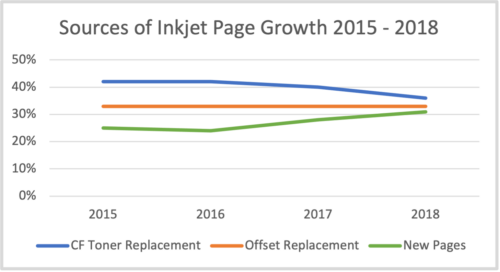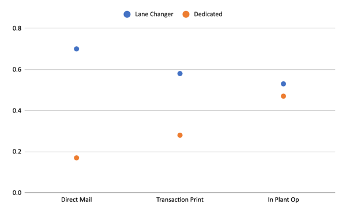Once upon a time, digital printing for transaction printers and direct mailers meant over-printing mono toner on pre-printed shells. Then full color toner came along and enabled personalization, improved response rates and faster turn-times for direct mail, but it was a bit too slow and a lot too pricey for bills and statements.
When full-color inkjet became viable for customer communications, adoption was rapid and wide spread across most transaction print organizations producing more than 30 million images per month. Full-color toner continued to gain traction with direct mailers and, as color quality improved, direct mailers have also taken on inkjet to such an extent that digitally produced direct mail images exceeded offset in 2018, according to I.T. Strategies.
Naturally, these changes had economic benefits for the transaction printing and direct mail companies using inkjet, but these segments weren’t the only ones affected. Before the digital transition, all of that volume also required a commercial print product in the form of rolls of corporate letterhead or direct mail shells that inkjet quickly made redundant. Commercial printers were the net losers for much of the digital revolution and particularly with inkjet. It’s no wonder that commercial printers long had an attitude of “never inkjet.” Inkjet was the enemy that cannibalized pages.
Despite the fact that transaction printers and direct mailers were not specifically targeting commercial printers with their transition efforts, the impact was significant. At a time when inkjet annual page volumes were consistently growing in double digits, a big chunk of that growth was coming at the expense of commercial volumes.
Drawn from “The Continuous Feed Ink Jet Production Market-2017” from I.T. Strategies, Figure One shows that a full third of inkjet page growth in each year between 2015 and 2018 was driven by reductions in offset volumes.
Source: I.T. Strategies
The pull from offset continues steadily even as toner replacement declines and the volume of new inkjet pages begins to increase. At the time this study was published, sheet-fed inkjet volumes were still in their infancy. B2 sheet fed presses started hitting the market about eight years ago, targeting commercial and other graphic arts applications. But they did not offer the same compelling cost model to commercial printers that continuous inkjet offered transaction printers and direct mailers. In 2015, the Canon i300 became commercially available, followed by the Xerox Brenva in 2016. Like their continuous cousins, the devices were more of a draw for transaction printers and direct mailers, but they still added to the pull of volumes out of commercial print shops.
Fast forward to 2020 and Canon and Xerox have both upped their sheet-fed game with the Canon iX Series and the Xerox Baltoro to directly pursue the commercial printing market. Landa now has a production B1 press targeting commercial printing and their partner, Komori will have a fast-follow in 2021 with the NS-40 B1 press.
In the past two years, leading continuous feed OEMs such as Canon, HP, Kodak, Screen and Ricoh have all delivered new devices supporting high-coverage, high-resolution devices that drive superior print quality on offset stocks.
In fact, prior to the pandemic, most production inkjet OEM development and marketing expenditures were being driven toward buyers in the commercial printing market. Prior to the pandemic, that was working very well for the OEMs and their customers and once COVID is out of our health and economic systems that success is expected to continue. However, just as adoption of inkjet in transaction printing and direct mail had a knock-on effect on commercial printers, the adoption of inkjet in the graphic arts space may have some side-effects for other markets as well.
Inkjet changes the game for everyone.
What we have learned from early adopters of inkjet and the impact on those markets is that companies who buy inkjet often see significant changes to their business model as a result. A company may buy inkjet to meet a particular need, but quickly find that there are more things that they can do. In fact, often the productivity of the devices forced companies to go and look for new things to do because they had so much remaining capacity on the device after their existing work was run.
The economies of scale are tremendous on continuous feed inkjet, so not running your device at high capacity is like throwing away money. With transaction printing, it was very natural to look for other volume to fill in production peaks, and often that volume came from direct mail, workbooks and directories. When companies can do more with their press, they can also look in more places for volume. They don’t have to stay in their lane to compete anymore.
In a 2019 survey, Inkjet Insight found that most transaction printers and direct mailers have become “lane changers” deriving less than half of their revenue from their stated segment focus.
As Figure Two shows, 70% of direct mailers, 58% of transaction printers and 53% of in-plant operations surveyed were “lane changers.”
Figure 2: Percentage of Lane Changers and Dedicated Operations by Segment (Direct Mail, Transaction Print, In Plant Operation)
Source: Inkjet Insight 2019 Data Analysis
Data from 120 direct mail companies indicated that only 17% earned more than 80% of their revenue from direct mail services. Out of 60 transaction printing organizations surveyed, only 28% earned more than 80% of their revenue from transaction printing services. This is less surprising since transaction printers typically offer non-print, e-delivery and archiving services, and programming can also be a large revenue source. However, the in-plant operations survey data was intriguing because it showed a strong correlation with inkjet adoption.
Of the 38 large in-plant operations reviewed, 47% remain dedicated to their core business. Drilling down on the 47% dedicated in-plants, only one company has inkjet. Conversely, when looking at the 53% of in-plants who have branched out, 40% of those companies have inkjet.
In-Plant operations are incredibly diverse, so a sample size of 38 companies is too small to know if these differences are driven by the industry supported or the type of print focus of the organization (commercial, transactional, direct mail, books, signage, etc.) but it does warrant further analysis.
Getting Ready for Change
Changing lanes isn’t always simple. While your inkjet device may be able to handle a variety of work, that doesn’t mean that your company knows how to sell or service that work. Direct mailers who have added aspects of transaction printing to their business may need more robust programming and data protection services as well as more finishing and mailing equipment.
Transaction printers moving beyond low coverage envelope mail needed to learn a lot more about color and media than they did before. They will also be selling to a very different client segment in marketing as compared to operations. It can be a lift, but it’s happening. Direct mailers and transaction printers are competing and, with increasing frequency, merging.
Now, commercial printers are getting into the inkjet game. Many have added inkjet to their offset (and toner) press portfolios. Like companies in other segments, they want their inkjet press busy – and they would rather take a turn at grabbing volume from someone else rather than cannibalizing their own presses. They may be competing for those “off peak” volumes like directories, workbooks or notices with transaction printers and direct mailers.
As all of these companies begin selling their inkjet-driven services into the same companies, the ability to do more than one thing can be a competitive advantage. Lane changers become game changers when they deliver a “one stop shop” experience to meet their customers’ printing needs. This is particularly true when selling to large brands who prefer to work with as few suppliers as possible.
There is another side effect from the push of inkjet into high-quality commercial production: higher expectations. Brand marketers, designers and print buyers are getting introduced to a whole new level of inkjet quality. It’s not business quality, or good enough quality, it’s offset quality or better, and it’s being produced on an inkjet press near you.
Color fidelity and print quality is becoming a competitive factor in segments that were previously not as color sensitive. Transaction printers who use profiling and ink limiting to control costs may find that companies are becoming more sensitive about their brand colors.
Because delivering top quality color is more expensive than “business color” companies need to be able to price appropriately for the service level delivered and educate customers on the rationale for cost differences. Ink is liquid gold and jobs need to be priced to account for relative ink usage. This many mean adding more papers and more profiles to deliver a competitive offer.
Inkjet Changes Markets
Inkjet is not only entering new markets, it’s changing the way we think about and operate in those markets. This article has focused primarily on three market segments, but inkjet is also moving into book production, magazines, directories, catalogs, signage, security printing and of course packaging and labels.
Inkjet pages in these markets are coming from companies buying inkjet to serve their segment, but also from lane changers dipping their toes into new areas. Fewer and fewer companies with inkjet are operating in a single application area. More often they are using inkjet to evolve into multiple markets and drive page growth.
This means that your competition may be coming from a different direction than you expect. Look all around and decide if it’s time for you to change lanes before the competition overtakes you.
More in our “Lane Changers and Game Changers” Series:
Full Circle with Toppan Merrill
Thomas Printworks: from Business Cards to Buildings
This post was originally published on PrintingNews.com



